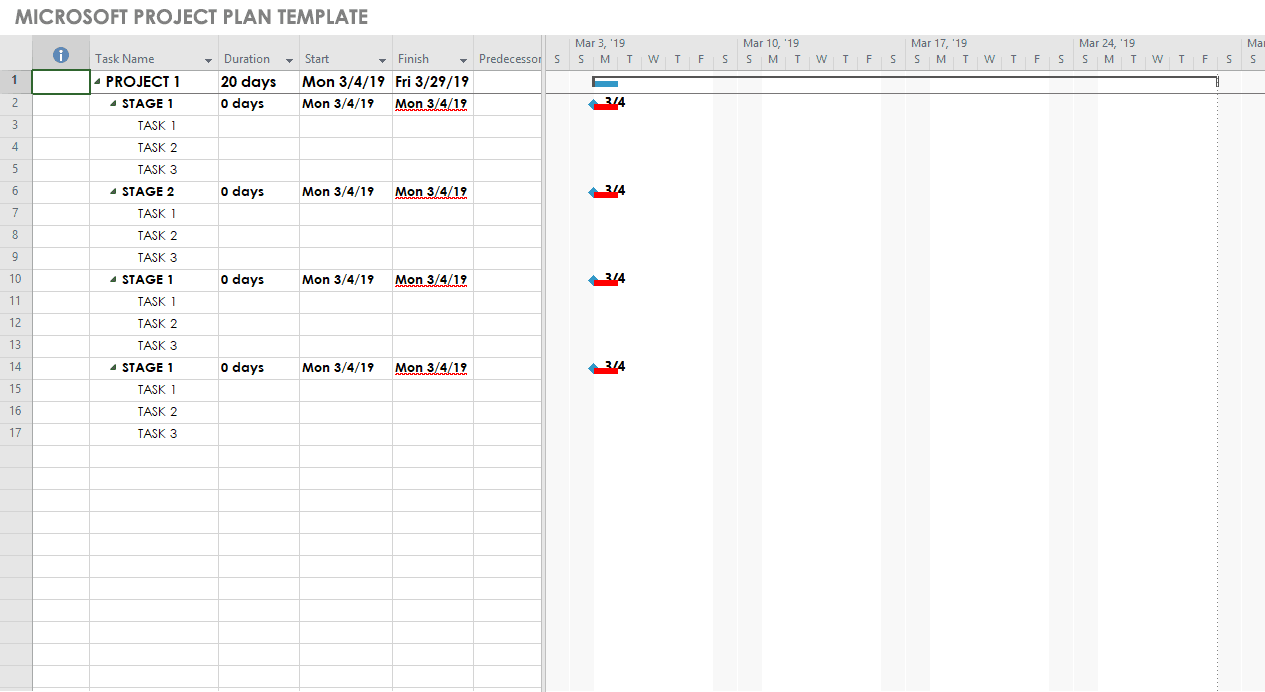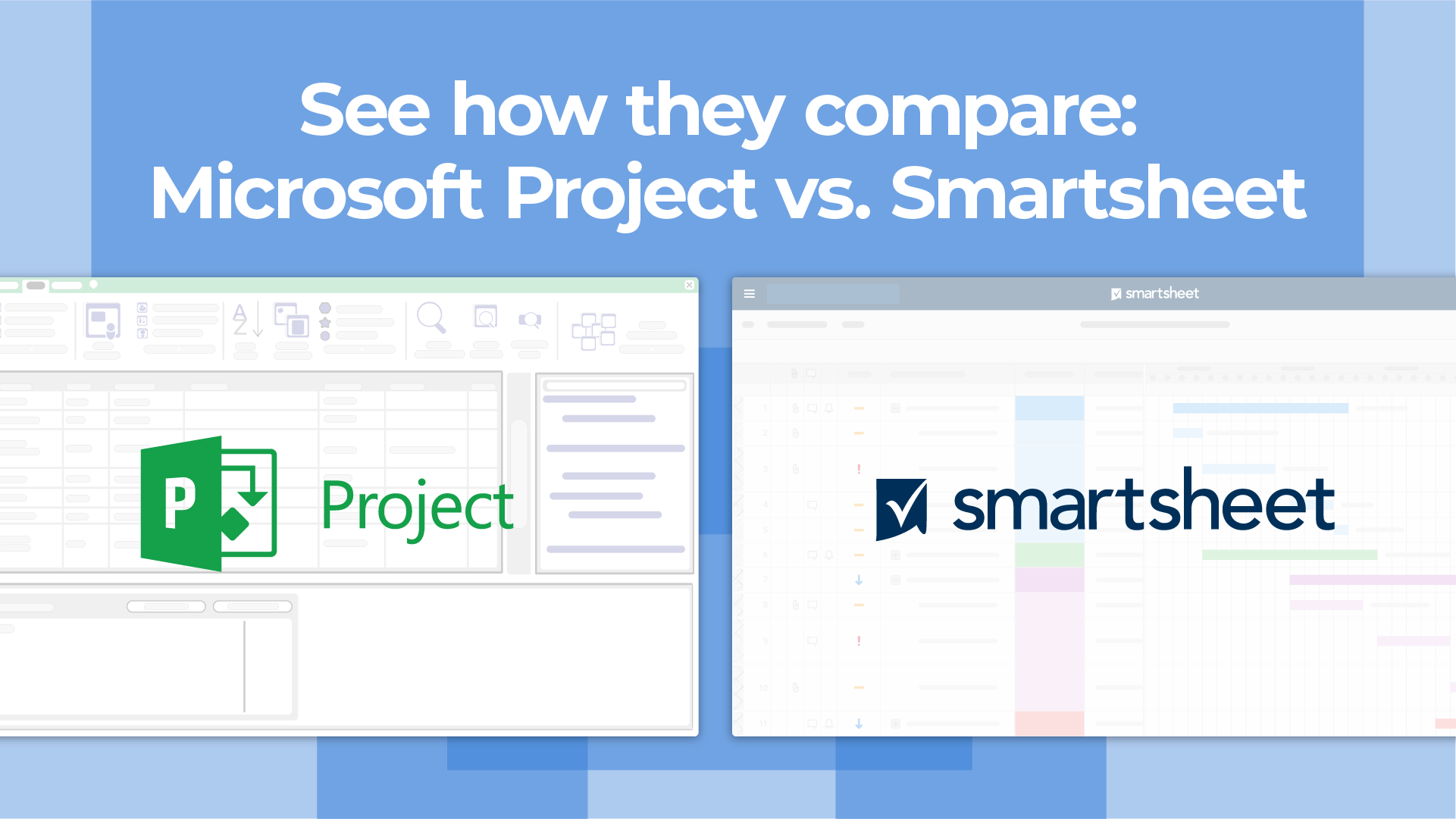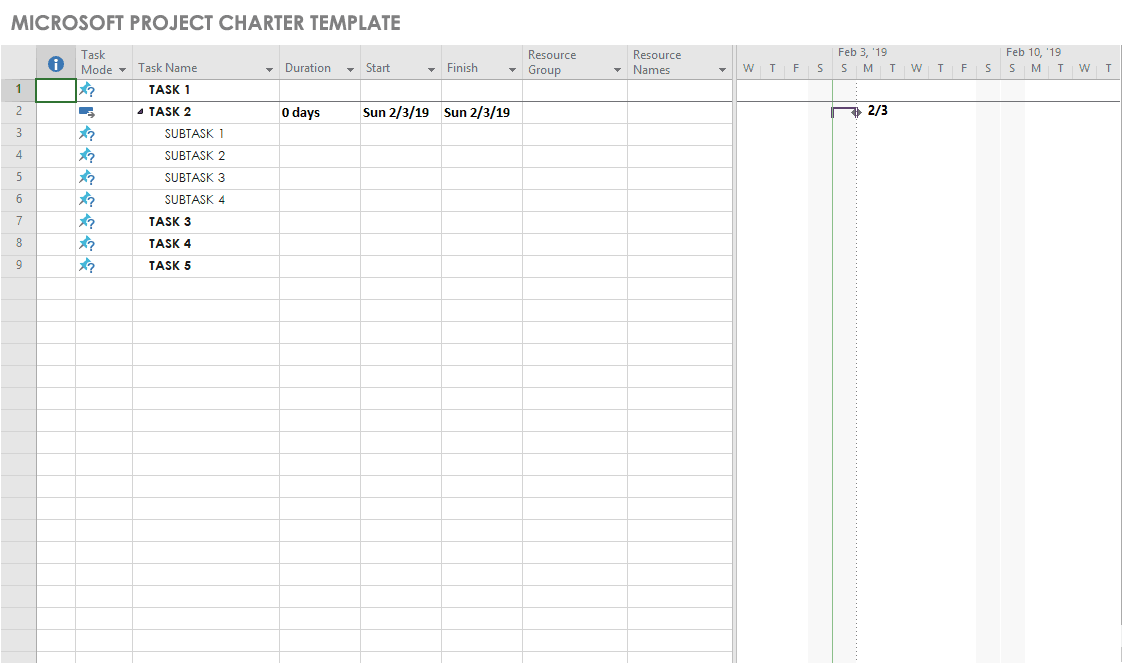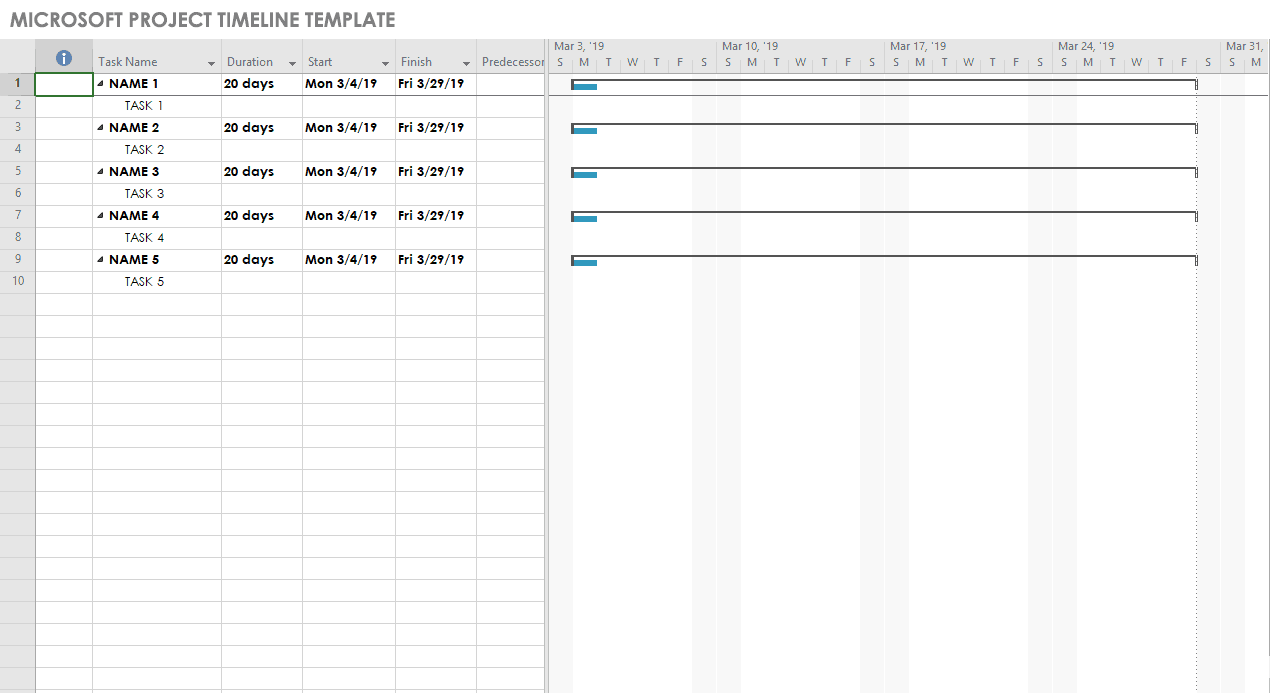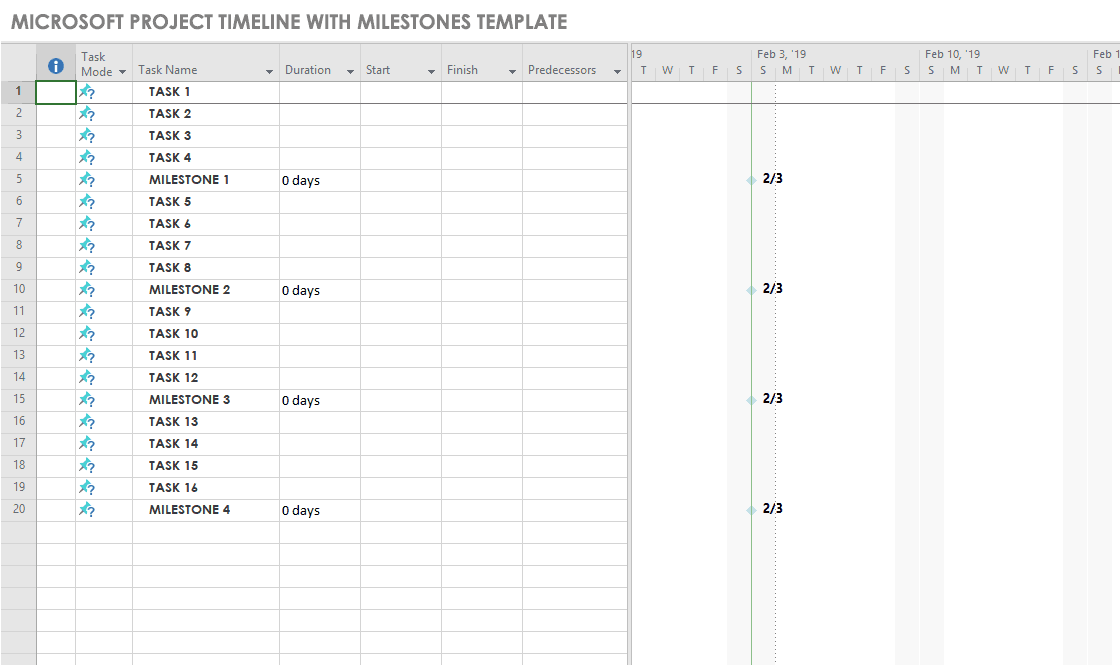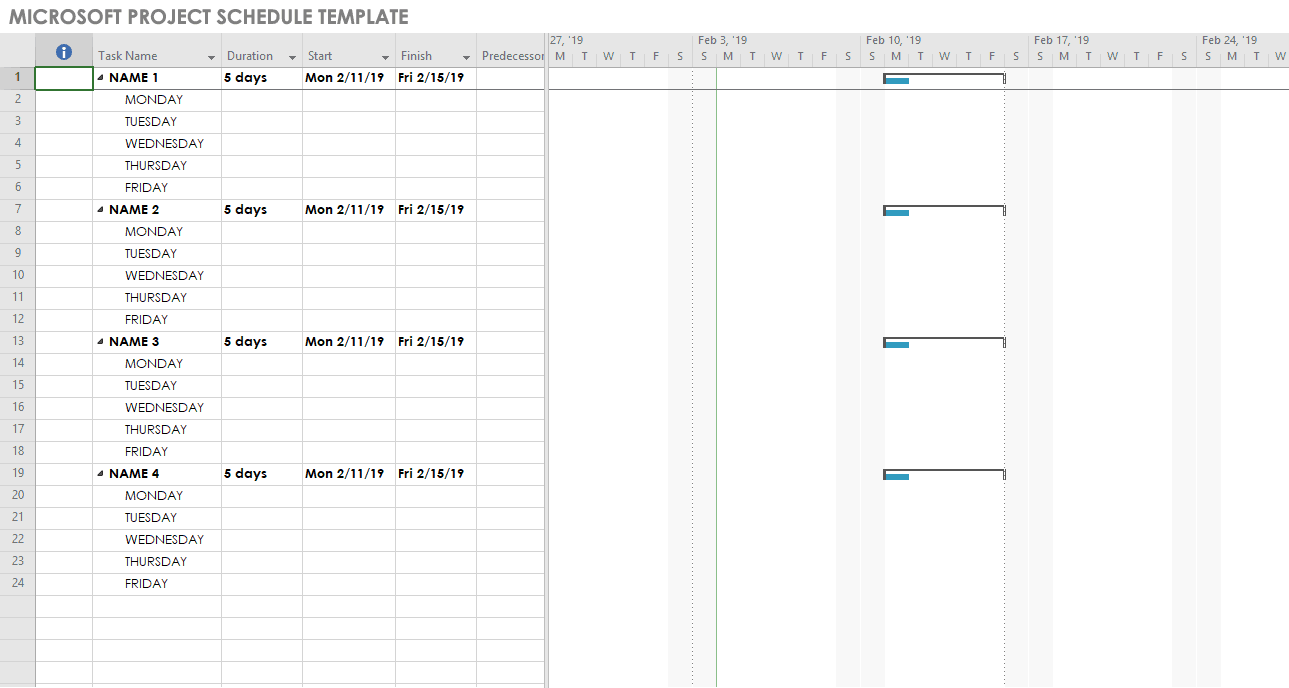Microsoft Project Plan Template
This template is designed for you to track your project from initiation to completion. Use this template to outline your project plan and include all key details of each phase, including project design, project development, and project evaluation. Track tasks against proposed completion dates and manage the human resources who own each project.
Download Microsoft Project Plan Template
See a head-to-head comparison of Smartsheet and Microsoft Project
Discover how these two tools compare across six key factors, including: user experience, shareability, reporting, automation, integrations, and price.
Microsoft Project Charter Template
With this simple template, organize and document your project’s scope as well as all of its needs, expected outcomes, and risks. This template includes space to document project managers and team members, objectives and goals, scope and schedule, and resources, so you can share key information with stakeholders to gain buy-in, lock in the budget, and get your project online.
Download Microsoft Project Charter Template
Microsoft Project Timeline Template
Outline your project timeline, track tasks on a daily, weekly, and monthly basis, and assign responsibilities to specific team members with this free Microsoft Project template. This template allows you the flexibility to design a timeline based on each phase of a project, giving you a good understanding of project completion dates. Run multiple timelines against one another so you can better delegate tasks and improve efficiency.
Download Microsoft Project Timeline Template
Microsoft Project Timeline with Milestones Template
Use this template to document and track your project timeline, plot milestones in order to visualize how your project is progressing, and gain quick insights about the health of your project. View your entire project on a comprehensive, built-in timeline, and make changes to the timeline as your project priorities and goals change.
Download Microsoft Project Timeline with Milestones Template
Microsoft Project Schedule Template
Schedule out your project’s tasks and team members’ responsibilities on a weekly basis to better understand your project’s timeline and ensure you hit crucial deadlines. Use this complete project schedule template to document the project’s task owners, due dates, and various task stasuses.
Download Microsoft Project Schedule Template
Microsoft Project Budget Template
Use this template to map out the financial details of your project, including labor and material costs, equipment and space costs, and actual spend versus projected budget. Monitor your expenses to ensure your project lands under budget, and detail each task and subtask to determine which parts of your project will need more of your allotted budget.
Download Microsoft Project Budget Template
Why Use a Template for Projects?
Using a template will help you execute your project with ease, save time when crafting project plans, and eliminate the need to manually create, document, and track crucial project components.
Templates for project management help you keep project managers and their teams productive by simplifying the processes that go into project planning, budgeting, and scheduling. In addition, project management templates also provide the following advantages to companies that implement them:
-
Share project plans and reports across your organization to keep everyone on the same page.
-
Follow industry best practices and streamline project management techniques.
-
View project activities, tasks, milestones, and budgets quickly and in real time.
-
Customize timelines and schedules to represent specific data, and leverage them as a scheduling tool for the rest of your organization in order to avoid any scheduling issues.
-
Track project progress visually, quickly view task dependencies, and update status and project priorities as needed.
-
Outline scope, objectives, and stakeholders to improve consistency across similar projects or tasks.
-
Manage your team’s schedule to ensure that you complete all tasks on time and on budget. Also, share your team’s schedule in an accessible format.
-
Break down larger projects into constituent, easier-to-digest tasks, and establish work packages that your team can easily deliver on.
-
Delegate tasks and solve issues more easily to better ensure project success.
-
Keep stakeholders updated on project progress.
-
Accelerate communication with your team and alert teams about issues with a standardized, templated communication system.
-
Develop project logic to ensure that no detail or deadline is overlooked.
Who Uses Project Templates?
Project managers and teams leverage all kinds of project templates to save time, improve efficiency, and ensure that they have covered all of their bases when identifying everything, from key project tasks to project budgets, and even project scope.
Anyone from beginners needing real-world experience with project plans to experienced planners and PMs who need to upgrade their project management processes use templates to streamline their project efficiency and visibility.
You can use project templates in a variety of circumstances, including for software development projects, website launches, conferences and events, marketing campaigns, construction and contractor-based projects, human resources projects, and even government jobs.
An Overview of Critical Project Components
Every project starts with thorough planning, moves to execution, and ends with an analysis. Here are the steps that are involved in planning a project from start to finish:
-
Pre-Planning: This process involves the creation of a project charter to establish the core components of the project at hand, a cost-benefit analysis to determine how effective the project will be, and, potentially, a Six Sigma project plan, if applicable to the project.
-
Risk Assessment: The next step is to identify all the risks that are involved with your project, usually in the form of a risk assessment matrix. Doing so will help you document the risk probability, impact, priority, mitigation, and response for your specific project. A root cause analysis might also be a good tool to have on hand, should a problem arise. The analysis will allow you to get to the bottom of an issue quickly and efficiently. Should any problems or changes to your project occur, a change management template will help you troubleshoot and resolve any unplanned events.
-
Stakeholder Analysis: After the project plan is complete, you should start to loop in key stakeholders to gain buy-in and secure budget. You should also develop a communication plan to determine what kind of management the stakeholders want to have over the project.
-
Scheduling and Task Tracking: Once you have nailed down the project and stakeholder plans, you can start scheduling your project and breaking down each phase into smaller parts for better efficiency. To do so, many PMs use a variety of scheduling templates and techniques, like PERT charts, critical path methods, workflow process diagrams, RACI matrices, and work breakdown structures.
How to Create a Template in Microsoft Project
Microsoft Project offers customizable templates for a variety of use cases, ranging from project timelines to project budgets. To create a new template in Microsoft Project, first select and open the project or template that you want to use as the basis for your new project.
Then, select File and Info. Under project information, change the project’s start and end dates to match your own project’s timeline. Click Save As and save this new template to your computer.
Clean up any existing project information that was inputted as an example, and fill in the spaces with details relevant to your own project. For example, set working hours, holidays, and employee schedules in a monthly calendar template, or add project summaries and task lists in a project charter template.
Once completed, save the project and update it as needed or as your project or version changes. For a more in-depth look at how to create a project timeline in Microsoft Project, or MS Project licensing information, check out this guide.
Use Free Microsoft Project Templates with Smartsheet for Project Management
From simple task management and project planning to complex resource and portfolio management, Smartsheet helps you improve collaboration and increase work velocity -- empowering you to get more done.
The Smartsheet platform makes it easy to plan, capture, manage, and report on work from anywhere, helping your team be more effective and get more done. Report on key metrics and get real-time visibility into work as it happens with roll-up reports, dashboards, and automated workflows built to keep your team connected and informed.
When teams have clarity into the work getting done, there’s no telling how much more they can accomplish in the same amount of time. Try Smartsheet for free, today.
